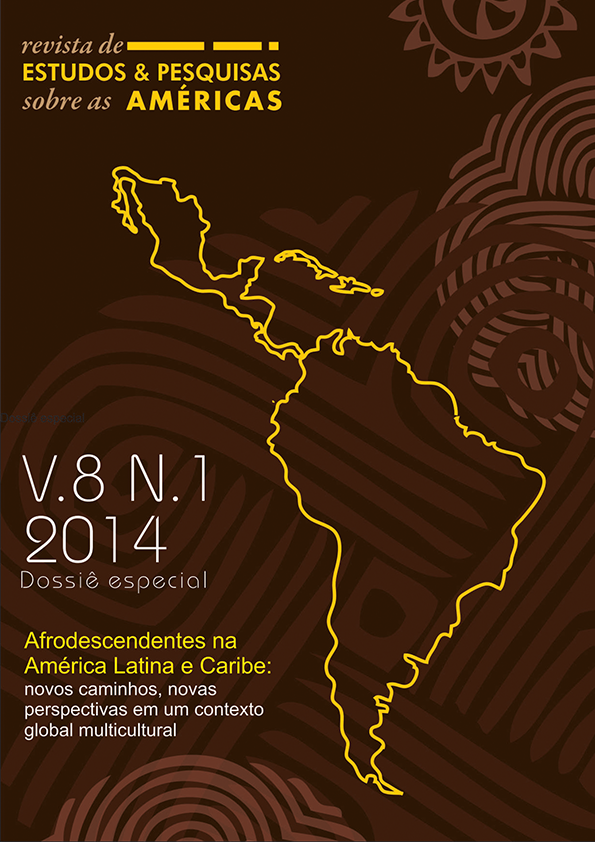Los afrodescendientes y el giro hacia el multiculturalismo en las “nuevas” constituciones y otras legislaciones especiales Latinoamericanas: particularidades de la región andina
Abstract
Desde la década de 1990, después de la adopción depolíticas “multiculturales’’ dirigidas específicamente a poblaciones indígenas y afrodescendientes por instituciones multilaterales y de gobernanza mundial, tales como agencias de las Naciones Unidas, de la Organización Mundial de la Salud, y otras, y también como resultado del activismo político de las comunidades indígenas y afrodescendientes, muchos estados-nación latinoamericanos revisaron o reemplazaron sus constituciones y en ocasiones aprobaron leyes especiales que expresan una preocupación por una mayor inclusión de esas poblaciones. La invisibilidad real de las poblacionesÂ
indígenas y afrodescendientes en los textos constitucionales anteriores en los cuales “las poblaciones nacionales” eran mencionadas como simplemente homogéneas sin distinciones étnicas o raciales, fue reemplazada por un reconocimiento inequívoco de las poblaciones nacionales étnicamente y racialmente plurales en “nuevas” constituciones a orientación multiculturalista. Es en ese contexto que surgió lo que Charles Hale llama el indio permitido (literalmente la “identidad india permitida”) y que las poblaciones afrodescendientes latinoamericanas ganaron una mayor visibilidad y margen de maniobra en comparación con su exclusión o construcción marcada como (últimos) otros durante el previo período de “mestizaje monocultural’’. En este ensayo, queremos evaluar de manera comparativa estas nuevas constituciones y leyes especiales, examinando cualitativamente las formas por las cuales estos textos se refieren a poblaciones afrodescendientes. Queremos descubrir y comparar””antes y más allá del hecho de que los Afrodescendientes son por ahora, finalmente, mencionados como parte integral de la población nacional””el tipo de derechos que se les da y el tipo de “sujetos” en que fueron construidos en los discursos sobre la nación que las constituciones y otros instrumentos jurídicos representan inevitablemente.
Palabras-clave: Constituciones Nacionales, políticas multiculturales, afrodescendientes
---
Os afrodescendentes e à transição para o multiculturalismo nas "novas" constituições latino-americanas e outras leis especiais: peculiaridades da região andina
A partir da década de 90, em seguida a adoção de políticas “multiculturais”, dirigidas especificamente à s populações indígenas e afrodescendentes, por instituições multilaterais e de governança mundial, tais como as Nações Unidas, a Organização Mundial da Saúde e outras, e também como resultado do ativismo político das comunidades indígenas e afrodescendentes, muitos estados-nações latinoamericanos revisaram ou substituíram suas constituições e/ou, em alguns casos, aprovaram leis especiais que expressam uma preocupação com uma maior inclusão dessas populações. A invisibilidade real das populações indígenas e afrodescendentes nos textos constitucionais anteriores, nos quais as “populações nacionais” eram mencionadas como simplesmente homogêneas, sem distinções étnicas ou raciais, foi substituída por um reconhecimento manifesto das populações nacionais étnica e racialmente plurais nas “novas constituições” à orientação multiculturalista. É nesse contexto que surgiu o que Charles Hale chamou de “índio permitido”, literalmente a “identidade índia permitida”, e que as populações afrodescendentes latino-americanas ganharam uma maior visibilidade e margem de manobra, em comparação com sua exclusão ou construção marcada como (últimos) “outros” durante o prévio período de “mestiçagem monocultural”. Nesse artigo, queremos avaliar de maneira comparativa essas novas constituições e leis especiais, examinando qualitativamente as formas pelas quais esses textos referem-se a populações afrodescendentes. Queremos descobrir e comparar ”“ antes e além do fato de que os afrodescendentes são agora, finalmente, mencionados como parte integral da população nacional ”“ o tipo de direitos que lhes é concedido e o tipo de “sujeitos” em que foram concebidos nos discursos sobre a nação que as constituições e outros instrumentos jurídicos inevitavelmente representam.
Palavras chaves: Constituições Nacionais, políticas multiculturais, afrodescendentes
---
Afrodescents and the shift towards multiculturalism in the "new" Latin American constitutions and other special laws: peculiarities of the Andean region
 From the 90s, then the adoption of "multicultural" policies, specifically targeted at indigenous and Afro-descendant populations, by multilateral institutions of global governance such as the UN, the World Health Organization and others, as well as a result of the political activism of indigenous and Afro-descendant communities, many Latin American nation-states have revised or replaced their constitutions and/or, in some cases, passed special laws that express a concern for greater inclusion of these populations.A real invisibility of indigenous peoples and Afro-descendants in previous constitutions, in which "national populations" were mentioned as simply homogeneous, without ethnic or racial distinctions, was replaced by a manifesto of ethnically and racially plural recognition in national populations' "new constitution" to the multiculturalist orientation. Is in this context that emerged what Charles Hale called "Indians allowed", literally "Indian identity allowed" and that Latin American Afro-descendants have gained greater visibility and leeway compared to its exclusion or construction marked as (last) "other" during the preliminary period of "monocultural miscegenation." In this article, we review, comparatively, these new constitutions and special laws, qualitatively examining the ways in which these texts refer to Afro-descendant populations. We want to find and compare - before and beyond the fact that Afro-descendants are now finally mentioned as an integral part of the national population - the kind of rights granted to them and the kind of "subjects" that were designed in the discourses about nation that constitutions and other legal instruments inevitably represent.
Keywords: National Constitutions, multicultural policies, African descent
Downloads
Downloads
Published
How to Cite
Issue
Section
License
The published material is the property of the Journal, and may be reproduced in whole or in part with indication of the source.
Copyright: Authors will be responsible for obtaining the copyright of the material used. Authors who publish in this journal agree to the following terms:
a)Authors retain the copyright and grant the journal the right of first publication, with the work simultaneously licensed under
the Creative Commons Attribution License which allows the sharing of work with acknowledgment of authorship and initial publication in this journal.
b) Authors are authorized to take additional contracts separately, for non-exclusive distribution of the version of the work published in this journal (eg, publish in institutional repository or as a book chapter), with acknowledgment of authorship and initial publication in this journal.
c) Authors are allowed and encouraged to publish and distribute their work online (eg in institutional repositories or on their personal page) at any point before or during the editorial process, as this can generate productive changes as well as increase the impact and the citation of the published work (See The Effect of Free Access).
















